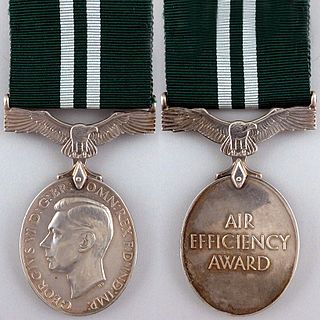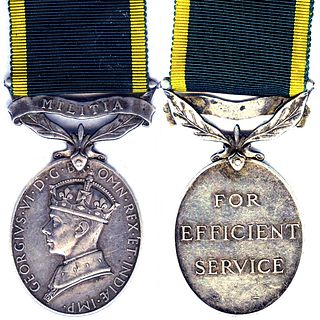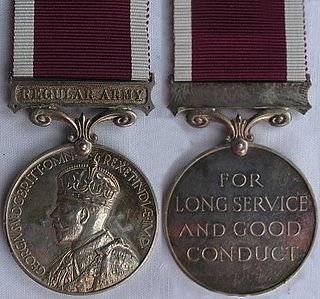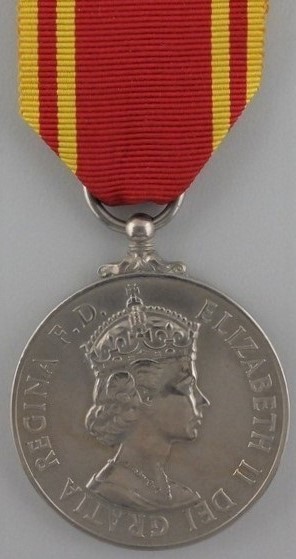
The Air Efficiency Award, post-nominal letters AE for officers, was instituted in 1942. It could be awarded after ten years of meritorious service to officers, airmen and airwomen in the Auxiliary and Volunteer Air Forces of the United Kingdom and the Territorial Air Forces and Air Force Reserves of the Dominions, the Indian Empire, Burma, the Colonies and Protectorates.

The Efficiency Medal was instituted in 1930 for award to part-time warrant officers, non-commissioned officers and men after twelve years of efficient service on the active list of the Militia or the Territorial Army of the United Kingdom, or of the other Auxiliary Military Forces throughout the British Empire. At the same time a clasp was instituted for award to holders of the medal upon completion of further periods of six years of efficient service.

The Meritorious Service Medal (MSM) is a British medal awarded to Senior Non Commissioned Officers and Warrant Officers of the British armed forces for long and meritorious service. From 1916 to 1928, eligibility was extended to cover both valuable services by selected other ranks irrespective of length of service, and for gallantry not in the face of the enemy.

The Medal for Long Service and Good Conduct (Military) is a medal awarded to regular members of the armed forces. It was instituted by King George V in 1930 and replaced the Army Long Service and Good Conduct Medal as well as the Permanent Forces of the Empire Beyond the Seas Medal. The medal was originally awarded to Regular Army warrant officers, non-commissioned officers and men of the UK Armed Forces. It also had a number of territorial versions for the Permanent Forces of the British Dominions. The eligibility criteria were relaxed in 1947 to also allow the award of the medal to officers who had served a minimum period in the ranks before being commissioned. Since 2016, the eligibility was widened to include officers who had never served in the ranks, and so the medal can now be awarded to all regular members of the British Armed Forces who meet the required length of service.

The Efficiency Medal (South Africa) was instituted in 1930 for award to part-time warrant officers, non-commissioned officers and men after twelve years of efficient service on the active list of the Citizen Force of the Union of South Africa. At the same time, a clasp was instituted for award to holders of the medal upon completion of further periods of six years of efficient service. The medal superseded the Colonial Auxiliary Forces Long Service Medal.
The Long Service and Good Conduct Medal is a military award recognizing 14 years of exemplary and unblemished service by non-commissioned and other ranks members of the New Zealand Defence Force. Established in 1985, these medals replaced the British Long Service and Good Conduct Medals with specific versions for New Zealand. There are three version of the Long Service and Good Conduct Medal, one each for the New Zealand Army, Royal New Zealand Navy, and the Royal New Zealand Air Force.
The Hong Kong Disciplined Services Medal was a long service medal awarded to members of the Hong Kong Disciplined Services in British Hong Kong. Established by Royal Warrant 8 July 1986, the award of the medal was intended to replace the awarding of the Imperial Service Medal. This medal was replaced by both the Hong Kong Customs & Excise Long Service Medal and the Hong Kong Immigration Service Long Service Medal, for long service to members of the respective disciplined services, upon the transfer of sovereignty in 1997, however the same ribbon continues to be used for the Hong Kong Immigration Service Long Service Medal.

The Royal Naval Volunteer Reserve Long Service and Good Conduct Medal, initially designated the Royal Naval Volunteer Reserve Long Service Medal, was instituted in 1908. It could be awarded to part-time ratings in the United Kingdom's Royal Naval Volunteer Reserve after twelve years of service and good conduct. The medal was a Naval version of the Volunteer Long Service Medal and its successor, the Territorial Force Efficiency Medal.
The Ulster Defence Regiment Medal is a long service medal awarded to part-time members of the Ulster Defence Regiment. Established in 1982, the medal was awarded for 12 years of long and efficient service, with a bar being awarded for each subsequent six years of qualifying service. Officers awarded the medal were entitled to use the post-nominal UD. The medal was replaced by the Northern Ireland Home Service Medal in 1992. Full-time members of the Ulster Defence Regiment were eligible for the Medal for Long Service and Good Conduct after 15 years of service.
The Northern Ireland Home Service Medal is a long service medal awarded to members of the Ulster Defence Regiment and its successor the Royal Irish Regiment. Established in 1992, the medal is awarded for 12 years of long and efficient service. Clasps are awarded for six subsequent years of qualifying service. The medal replaced the Ulster Defence Regiment Medal.

The Fire and Rescue Service Long Service and Good Conduct Medal was established in June 1954 as a long service medal awarded to members of fire and rescue services throughout the United Kingdom, the Isle of Man and the Channel Islands. It was first designated The Fire Brigade Long Service and Good Conduct Medal and subsequently renamed in 2022 following an updated royal warrant. The medal is awarded for 20 years of good and efficient service.
The New Zealand Fire Brigades Long Service and Good Conduct Medal is a meritorious and long service award for members of recognized fire services in New Zealand who have completed 14 years of service.

H.M. Coastguard Long Service and Good Conduct Medal is a long service medal awarded by the United Kingdom. Awarded for twenty years full or part-time service, with members of His Majesty's Coastguard, Coastguard Rescue Service, Isle of Man Coastguard and auxiliary coastguards eligible.

The Prison Services Long Service and Good Conduct Medal was established by Royal Warrant on 17 December 2010. The medal is awarded for long service to members of the various prison services of the United Kingdom.

The Special Constabulary Long Service Medal is a long service medal awarded in the United Kingdom to members of the Special Constabulary who have completed a specified period of service. Established in 1919 by King George V, the medal was initially created to reward members of the Special Constabulary for their service during World War I.

The Medal for Long Service and Good Conduct (South Africa) (Medalje vir Langdurige Diens en Goeie Gedrag) is a distinctive South African version of the British Medal for Long Service and Good Conduct (Military). It was awarded to members of the Permanent Force of the Union of South Africa who had completed eighteen years of reckonable service.

The Naval Long Service and Good Conduct Medal (1848) is a long service medal awarded to regular members of His Majesty's Naval Service. It was instituted by Queen Victoria to replace the Naval Long Service and Good Conduct Medal (1830), and could be awarded to other ranks and men serving in the Royal Navy and Royal Marines. Since 2016, after a number of changes in eligibility, all regular members of the Royal Navy and Royal Marines who have completed fifteen years of reckonable service can be awarded the medal.

The Royal Air Force Long Service and Good Conduct Medal is a medal awarded to regular members of the Royal Air Force in recognition of long service. It was instituted by King George V in 1919, the year following the establishment of the world's first independent air force. At first, the medal was awarded to Regular Force non-commissioned officers and airmen of the Royal Air Force. The award criteria were later relaxed to also allow the award of the medal to officers who had served a minimum period in the ranks before being commissioned. Since 2016, it is awarded to all regular members of the RAF, including officers who had never served in the ranks.

The Special Reserve Long Service and Good Conduct Medal was a long service medal awarded by the United Kingdom. The medal was awarded for service in the Army Special Reserve, or a combination of service in the Special Reserve and other part-time military forces. Awarded between 1908 and 1930, the medal was only awarded 1,078 times.
The New Zealand Traffic Service Medal is a long service award for uniformed Traffic Officers or Road Traffic Instructors. This includes officers of the Ministry of Transport as well as officers of local authorities. Eligible personnel must have been serving on or after 1 January 1987 but before 1 July 1992. The medal recognises those who have completed 14 years of continuous service.













